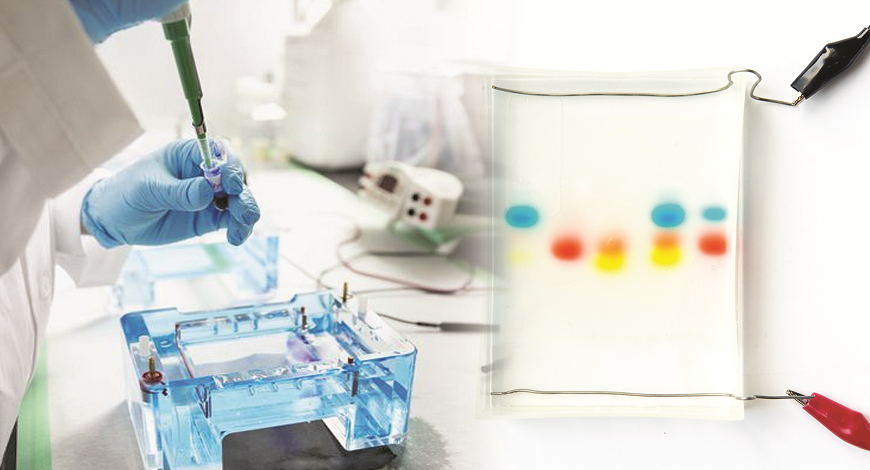Electrophoresis
Modern Improvements to Classic Technologies

The focus of the industry remains to introduce best technologies that offer high throughput and improved sensitivity. New strategies have been proposed to develop high-sensitive, portable, or miniaturized devices.
Electrophoretic separation was first demonstrated in the year 1807 and has since been a staple tool used by biologists and chemists for more than a century since its inception. From the initial crude paper electrophoresis system to today’s modern automated electrophoresis system, the development of electrophoresis systems has been driven by the advancement of technology such as miniaturization, precision engineering, biochemistry, electrical, and electronics. These advancements were reintroduced to meet the requirement for faster and better resolution of results.
Global market
The global electrophoresis market is expected to reach USD 2.8 billion by 2022 from an estimated USD 2.26 billion in 2018, reflecting a CAGR of 5.4 percent, according to Markets and Markets. The growing trend for DNA profiling will drive the growth prospects for the global gel electrophoresis market for the next 4 years. One of the major factors responsible for the growing need for DNA profiling is paternity testing, which compares the DNA of the offspring of the father. Also, DNA profiling is used in forensic investigations to identify suspects or victims based on crime scene DNA electrophoresis. The increase in forensic research for accurate crime investigations will drive the demand for gel electrophoresis for the analysis of DNA.
The global gel electrophoresis market is highly competitive and diversified due to the presence of a large number of regional and international vendors across the globe. It has been observed that regional vendors find it increasingly difficult to compete against international players based on features such as quality, pricing, market reach, and financial resources. Furthermore, the competitive environment in the market will increase due to the growing number of product or service extensions, product innovations, and mergers and acquisitions (M&As).
The laboratory research segment accounted for the majority market share during 2018 and will continue to dominate the market for the next 4 years. The growing demand for personalized medicines and research activities for drug discovery will accelerate the rate of demand for lab analytical instruments such as gel electrophoresis. In addition, the presence of a high number of research laboratories in regions such as North America and Europe, providing a high-quality instrument, continuous product improvements, and innovation will also lead to the market segment’s growth.
Some of the prominent companies operating in this segment are Bio-Rad Laboratories Inc., Danaher Corporation, Thermo Fisher Scientific Inc., Qaigen N.V., PerkinElmer Inc., Sigma-Aldrich Corporation, Harvard BioScience Inc., Agilent Technologies Inc., Helena Laboratories, GE Healthcare, and Shimadzu Corporation. M&As, partnerships, collaborations, expansions, joint ventures, agreements, new product launches, and others are some of the strategies adopted by prominent companies to strengthen their position.
Technological advances
With the high versatility, major advancements have been made with regard to the instrumental set-ups over the years. The focus of the industry remains to come up with the best technologies that offer high throughput and improved sensitivity. New strategies have been proposed to develop high-sensitive, portable, or miniaturized devices.
CE-MS. The last decade has witnessed a revival in technological developments for CE-MS, while at the same time moving away from being a purely academic tool to one increasingly being adopted by industrial scientists. Until a few years ago, there was only one commercial supplier offering a technology solution, meaning little progression. But more recently, there have been new players entering the market with new technologies. This will get better and better, making CE-MS more sensitive and more robust. Some players are making impressive strides towards miniaturizing the technology, with the development of microfluidic CE-MS. Miniaturization will enable a lot of high-throughput work, without compromising the level of information they offer. This means that any process one wants to monitor will become more cost-effective.
Accelerating gel electrophoresis through stain-free technology. Although SDS-PAGE can satisfy requirements for both sample purity and yield, the process can take a full day. When time and costs are critical concerns, researchers often cannot afford to spend a full day verifying protein quality after each step of a purification workflow that includes multiple columns. Technology has attempted to reduce the time required for electrophoresis by increasing the speed of gel runs and decreasing time required for staining. But the greatest time decrease occurs when staining is completely removed from a procedure. Stain-free technology reduces run times to ≤30 minutes, thereby drastically cutting costs and time required to determine sample purity. The technology uses ultraviolet (UV) irradiation to target aromatic amino acids in native proteins. Stain-free technology also provides increased dynamic range, increased sensitivity, and a lower limit of detection compared with standard staining methods. Quality is not sacrificed for speed.
2D electrophoresis. Association of this technology with MS, in combination with computer-assisted software for image evaluation, has enabled 2DE analysis in comprehensive qualitative and quantitative examination of proteomes as well as in separation and selection of proteins. Currently, 2DE technology has gained special attention for its enormous ability to study differentially expressed proteins between different groups for comparative proteomic analysis to screen biomarkers and identification of drug targets for therapeutic management. Good sample preparation for solubilization of proteins, followed by protein extraction, is critical for efficient and reproducible 2DE. Conventional approaches for protein solubilization and modification do not reliably provide the best samples for the technology. Now, the commercially available kits for protein extraction and other purposes of 2DE are considerably simple to use and have improved the sensitivity and reproducibility of the 2DE technology; yet they have limited use.
High-speed CE with LIF detection. Currently, the miniaturization of high-speed CE systems has become one of the major development directions of technology, which can provide various portable instruments for point-of-care testing, in-situ analysis, and extraterrestrial exploration by means of their small size, high-resolution separation, and fast analysis time. So far, most of the miniaturized high-speed CE systems are developed on the basis of microchip-based CE technique with advantages of automated picoliter-scale sample injection and separation and high system integration. In the early stage of the development of miniaturized CE instruments, electrochemical detectors were adopted frequently due to their simple structure and small size.
Therefore, although it still presents great challenges in achieving miniaturization of laser-induced fluorescence (LIF) detectors due to their complex optical structure, currently LIF detection has become the major detection technique used in miniaturized CE instruments.
Microchip capillary electrophoresis. MCE has come up as a better alternative for monitoring and characterizing classical and novel formats of antibody-based bio-therapeutics as it offers a high-throughput approach
to speed up sample throughput with a resolution superior to conventional capillary electrophoresis. The vendors have come up with products which enable automated analysis of 96–384 samples in one run. MCE-SDS assays offer several advantages compared to the conventional CE-SDS in terms of faster time and better resolution.
Buyers’ perspective
- While procuring an electrophoresis system, buyers take into consideration:
- If they can blot in the same tank as they run the gels;
- If they can run precast and hand-cast gels with the same electrophoresis equipment;
- Number of gels, per experiment, can run at once in a single electrophoresis cell;
- Requirement of any special buffers or sample buffers to run their gel;
- If precast and hand-cast gel gives the same separation;
- Efficiency of transferring high-molecular-weight proteins from gel to a membrane; and
- Efficiency of transferring proteins from gel to a membrane.
Outlook
The technology of electrophoresis started in the beginning of the 19th century, and even after two centuries is still being practiced. Although present electrophoresis is being done in many different ways and methods, the equipment and style is quite different from the original design; yet the core principle remains the same. By following the trends in changes to the technology of electrophoresis, the next step of development would be miniaturization and portability of systems.
Second Opinion
Electrophoresis: State of Art Technology for Past, Present and Future
Dr Rohit Joshi
Research Scientist, School of Life Sciences
Jawaharlal Nehru University, New Delhi
Electrophoresis is used for separation of either proteins or nucleic acids, and has undergone a number of advancements from commonly used slab-gel electrophoresis (SGE) to recently developed biochip-based SGE systems by Zhang and Yamaguchi’s group. The electrophoresis market is primarily divided into gel electrophoresis (GE) and capillary electrophoresis (CE) technologies. Two-dimensional gel electrophoresis (2DE) provides basic approaches in proteomics for the separation and visualization of complex protein mixtures. Two-dimensional difference gel electrophoresis (2D-DIGE) is an acrylamide gel electrophoresis-based technique for protein separation and quantification in complex mixtures for the characterization of quality parameters of importance in the meat industry. In addition, it can also compare two or three protein samples on the same analytical gel, and establish differentially expressed protein levels between healthy normal and diseased pathological tissue samples, such as liver, testis, and lungs. Comparing tissue groups under different conditions is crucially important for advancing the biomedical field by characterization of cellular processes, understanding pathophysiological development, and tissue biomarker discovery. Similarly, targeted depletion of known abundant proteins with antibody columns has been successfully employed using DIGE to discover significant proteins associated with the disease phenotype.
Capillary electrophoresis, matrix-assisted laser desorption, and ionization time-of-flight mass spectrometry (MALDI-TOF-MS) and Brdicka reaction can be used to characterize human and rabbit metallothionein, despite having the same number of -sulfhydryl (-SH) groups. In addition, a method is developed, based on capillary zone electrophoresis coupled with a diode array detector (CZE-DAD), for simultaneous analysis of ibuprofen (IBU) and phenylephrine (PHE) in bulk and tablets. Using antibodies against cyclic citrullinated peptides (CCPs), rheumatoid arthritis (RA) can be diagnosed by capillary electrophoresis with laser-induced fluorescence detection (CE-LIF). Further, microchip capillary electrophoresis (MCE) can be used for on-chip detection of trace amounts of glyphosate and glufosinate residues in agricultural products, trace amounts of nitrite and nitrate in cerebrospinal fluid (CSF), trace amount of compound in medicinal plants, separation of hemagglutinin (HA) and nucleocapsid protein (NP) gene PCR products from influenza A (H1N1) virus, sex identification of ancient DNA samples, determination of functional proteins in infant milk formula, and topological DNA variants. Thiols in proteins can also be analyzed using microchip capillary electrophoresis with laser-induced fluorescence detection (μCE-LIF). Rapid determination of catecholamines (CAs) in urine samples can also be done, using non-aqueous microchip electrophoresis (NAMCE). Recently a research group of Prof Willis, from Jet Propulsion Laboratory, USA, suggested that microchip electrophoresis (ME) could be used in future NASA exploration missions, which can help in filling the gaps in our knowledge of life beyond earth.












